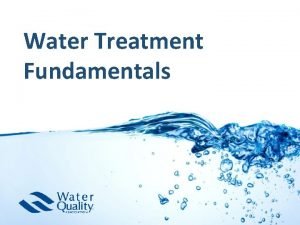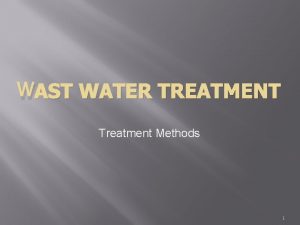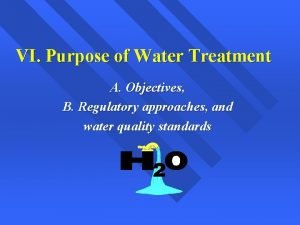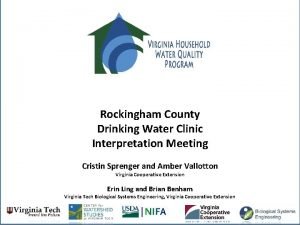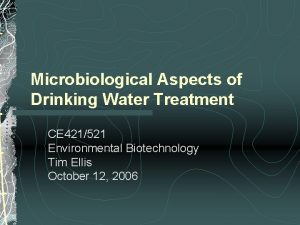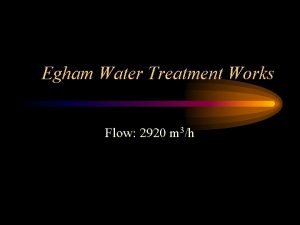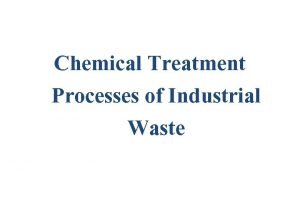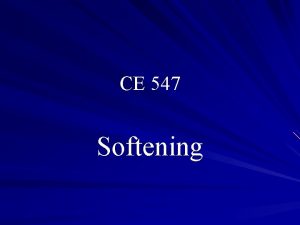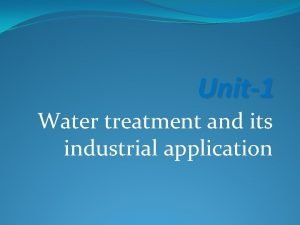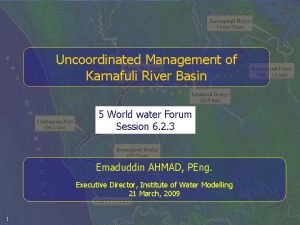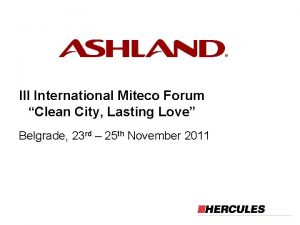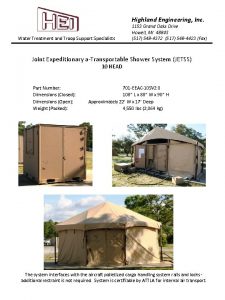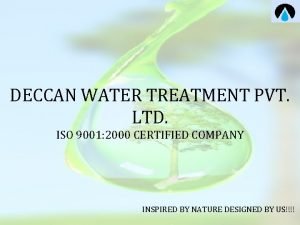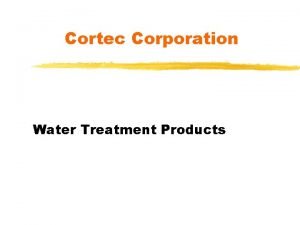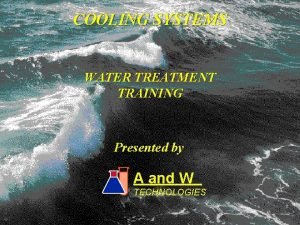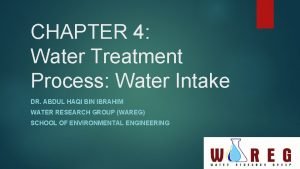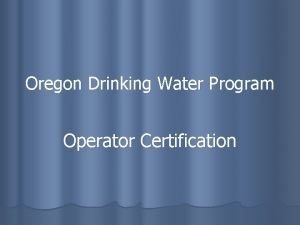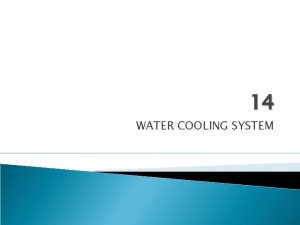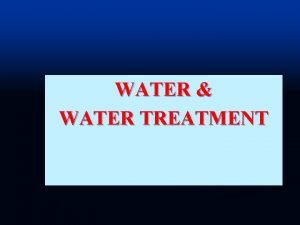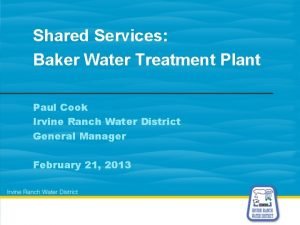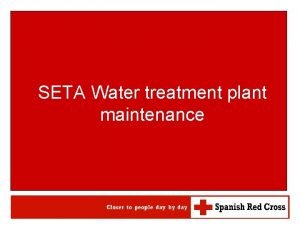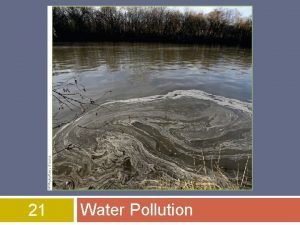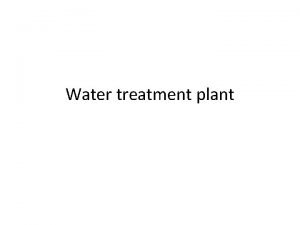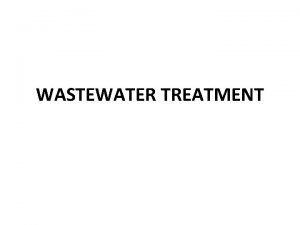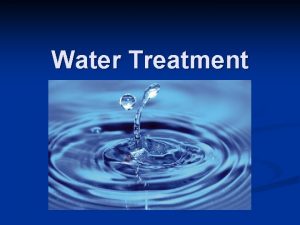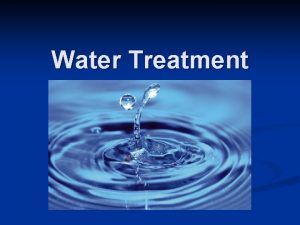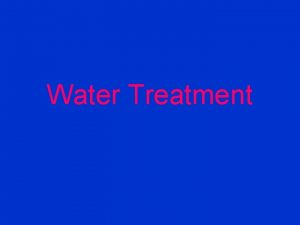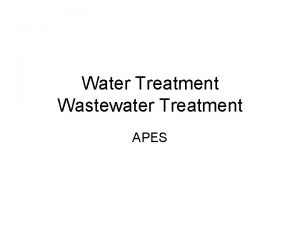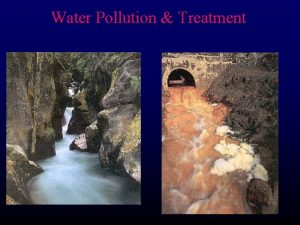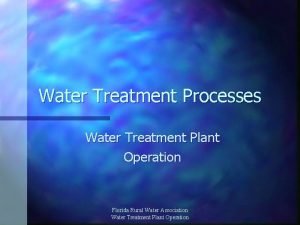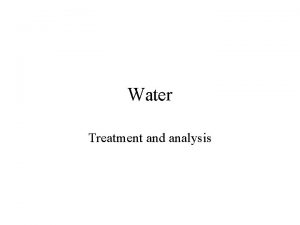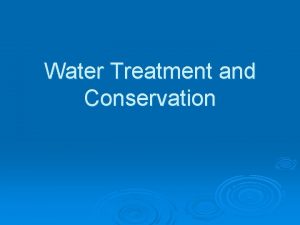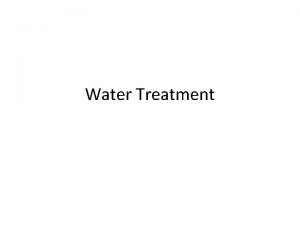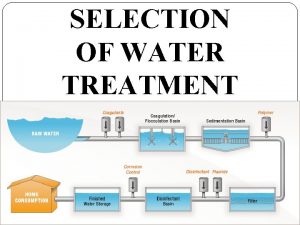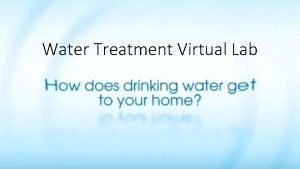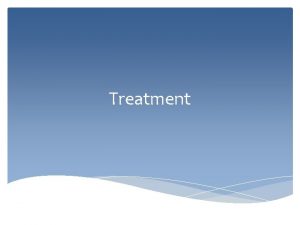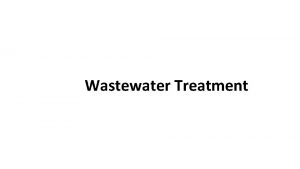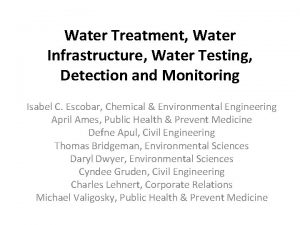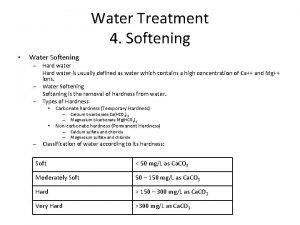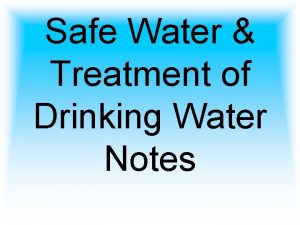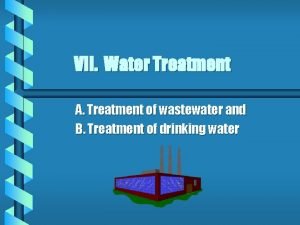TREATMENT OF WATER WHAT IS WATER TREATMENT Water

























- Slides: 25

TREATMENT OF WATER

WHAT IS WATER TREATMENT? Water treatment refers to the different methods of treatment required for removal or reduction of impurities to their acceptable limits in the most affordable and expedient manner possible.

TYPES OF IMPURITIES IN WATER 1. SUSPENDED SOLIDS Leaves, twigs, etc. 2. DISSOLVED Salts, Gases, etc. 3. COLLODIAL Clay, Silt, etc. 4. MICRO-ORGANISMS Fungi, Bacteria, Algae, etc.

BASIC TREATMENT PROCESS COAGULATION AIDED SEDIMENTATION SCREENI NG PUMPING AERATIO N FILTRATION COAGULATIO N DISINFECTI ON FLOCCULATI ON DISTRIBUTI ON SEDIMENTATI ON

1. SCREENING Screening is the first treatment station, both for surface and wastewater. This process essentially involves the removal of large non-biodegradable and floating solids that frequently enter a wastewater works, such as rags, papers, plastics, tins, containers and wood. It's purpose is to: 1. Protect the structure downstream against large objects which could create obstructions in some of the facility's units. 2. Easily separate and remove large matter carried along by the raw water, which might negatively affect the efficiency of later treatment procedures or make their implementation more difficult.

1. 1 TYPES OF SCREENS COARSE SCREEN FINE SCREEN 10 -25 Ф bars @ 20 -100 mm c/c distance Wire mesh with less than 20 mm c/c distance

2. PUMPING Its done to provide a controlled discharge into the water treatment plant.

3. AERATION Aeration brings water and air in close contact by exposing drops or thin sheets of water to the air or by introducing small bubbles of air (the smaller the bubble, the better) and letting them rise through the water. The scrubbing process caused by the turbulence of aeration physically removes dissolved matter. Its objectives are: 1. Removal of undesirable dissolved gases like CO 2, H 2 S, NH 3, etc. 2. Increase in dissolved O 2 content 3. Removal of volatile liquids like Phenol, Humic Acid, etc. 4. Removal of dissolved minerals like Fe & Mn.

3. 1 TYPES OF AERATORS A. Water-Into-Air Aerators Cascade Aerators Cone B. Air-Into-Water Aerators Spray Nozzle Aerators Diffused Bed

START OF COAGULATION AIDED SEDIMENTATION 4. COAGULATION Coagulation is a process that occurs when a coagulant is added to water to "destabilize" colloidal suspensions. The coagulation process involves the addition of the chemical (e. g. alum) and then a rapid mixing to dissolve the chemical and distribute it evenly throughout the water. This produces positive charges to neutralize the negative charges on the particles. Then the particles can stick together, forming larger particles which are more easily removed.

5. FLOCCULATION Now that the particles have a neutral charge and can stick together. The water flows into a tank with paddles that provide slow mixing and bring the small particles together to form larger particles called flocs. Mixing is done quite slowly and gently in the flocculation step to increase conjugation opportunity. If the mixing is too fast, the flocs will break apart into small particles that are difficult to remove by sedimentation or filtration.

6. SEDIMENTATION Next, the water flows to a tank called a sedimentation basin where gravity causes the flocs to settle to the bottom. Large particles settle more rapidly than small particles. It would take a very long time for ALL of the particles to settle out and that would mean we would need a VERY large sedimentation basin. So the clarified water, with most of the particles removed, moves on to the filtration step where the finer particles are removed.

6. 1 TYPES OF SEDIMENTATION TANK A. RECTANGULAR OR HORIZONTAL FILL TYPE

6. 1 TYPES OF SEDIMENTATION TANK B. CIRCULAR OR VERTICAL FLOW TYPE TANK

6. 2 SEDIMENTATION CONCEPT There are 2 important terms to understand in sedimentati on zone design: ‐settling velocity, Vs: The rate at which the particle is settling downward ‐Velocity at which the tank is designed to operate, called the overflow rate, Vo, the velocity of the liquid rising is the overflow rate. Overflow rate (Vo) must be less than or equal the settling velocity Vs

6. 2 SEDIMENTATION CONCEPT CONTD. Critical settling velocity is the settling velocity of particles which are 100% removed in the basin. • The percentage of particles removed in an ideal horizontal sedimentation tank: P = 100 Vs/ Vo Since smaller particles have lower settling velocities, if you want to remove smaller particles in the settling basin you have to have a lower overflow rate.

6. 2 SEDIMENTATION CONCEPT CONTD.

7. FILTRATION The process of passing the water through the beds of such granular materials is known as Filtration primarily depends on a combination of complex physical and chemical mechanisms, the most important being adsorption. Adsorption is the process of particles sticking onto the surface of the individual filter grains or onto the previously deposited materials. Forces that attract and hold particles to the grains are the same as those that work in coagulation and flocculation. In fact, coagulation and flocculation may occur in the filter bed, especially if coagulation and flocculation before filtration was not properly controlled. Incomplete coagulation cause serious problems in filter operation.

7. FILTRATION This filtering process is determined by two basic physical principles. First, relatively large suspended particles get stuck between the sand grains as they pass the filter medium (mechanical straining). Second, smaller particles adhere to the surface of the sand grains caused by the effect of the van der Waals forces (physical adsorption). A chemical filter-aid (i. e. coagulant or flocculent) might be added to promote additional adhesion. In the course of these processes, more and more particles accumulate in the filter medium, increasingly causing clogged filters and decreased performance.

7. 1 FILTRATION- TYPES OF FILTERS A. SLOW SAND FILTER They consist of fine sand, supported by gravel. They capture particles near the surface of the bed and are usually cleaned by scraping away the top layer of sand that contains the particles.

7. 1 FILTRATION- TYPES OF FILTERS B. RAPID SAND FILTER The rapid sand filter or rapid gravity filter is a type of filter used in water purification and is commonly used in municipal drinking water facilities as part of a multiple-stage treatment system. Rapid sand filters have filter rates 40 times those of slow sand filters.

8. DISINFECTION With particles removed, it only remains to provide disinfection so that no pathogens remain in the water. Protozoan pathogens are large in size and have been removed with other particles. Bacteria and viruses are now destroyed by addition of a disinfectant, chlorine (the same chemical present in bleach). Enough chlorine is added so that some remains to go out in the water distribution system, protecting the public once the water leaves the plant.

9. DISTRIBUTION SYSTEM The purpose of distribution system is to deliver water to consumer with appropriate quality, quantity and pressure. Distribution system is used to describe collectively the facilities used to supply water from its source to the point of usage. The distribution pipes are generally laid below the road pavements, and as such their layouts generally follow the layouts of roads. There are, in general, four different types of pipe networks; any one of which either singly or in combinations, can be used for a particular place. They are: Grid, Ring, Radial and Dead End System.

9. DISTRIBUTION SYSTEM CONTD. Requirements of Good Distribution System • Water quality should not get deteriorated in the distribution pipes. • It should be capable of supplying water at all the intended places with sufficient pressure head. • It should be capable of supplying the requisite amount of water during firefighting. • The layout should be such that no consumer would be without water supply, during the repair of any section of the system. • All the distribution pipes should be preferably laid one metre away or above the sewer lines. • It should be fairly water-tight as to keep losses due to leakage to the minimum.

THANKS A LOT! Presentation by: ADITYA GUPTA
 Water and water and water water
Water and water and water water Water treatment fundamentals
Water treatment fundamentals Wast water treatment
Wast water treatment What are the objectives of water purification
What are the objectives of water purification Water treatment rockingham county
Water treatment rockingham county Ground water treatment process
Ground water treatment process Water treatment works near me
Water treatment works near me Chemical oxidation water treatment
Chemical oxidation water treatment Split treatment water softening
Split treatment water softening Lime soda process of water softening
Lime soda process of water softening Mohra water treatment plant
Mohra water treatment plant Sonoxide ultrasonic water treatment
Sonoxide ultrasonic water treatment Highland engineering
Highland engineering Deccan water treatment
Deccan water treatment Cortec water treatment
Cortec water treatment Cooling tower water treatment training
Cooling tower water treatment training Intake water treatment process
Intake water treatment process Ce certification sewage treatment works
Ce certification sewage treatment works Oregon wastewater operator certification
Oregon wastewater operator certification Oni cooling system
Oni cooling system Objectives of water treatment
Objectives of water treatment Diemer water treatment plant
Diemer water treatment plant Water treatment plant
Water treatment plant Water treated from sewage treatment plant
Water treated from sewage treatment plant Water treatment process
Water treatment process Aquaculture wastewater treatment
Aquaculture wastewater treatment

